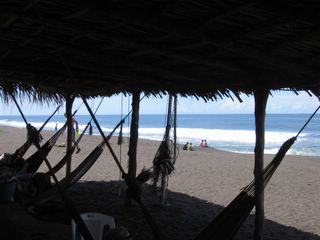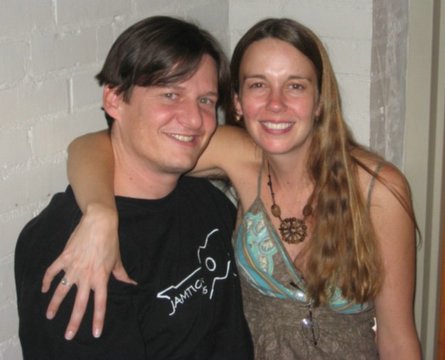
A local soccer practice near Antigua. In the background is Volcán Agua, one of Guatemala's many volcanoes.
We’re pretty sure that Guatemala offers one of the most fascinating combinations of natural beauty and cultural diversity in the Western hemisphere. (Not that we’ve been all over the hemisphere yet or anything, but we’ve read a lot.)

Volcán Santa María, which towers over our temporary home in Xela.
For one thing, Guate (as it’s often called by travelers) offers an amazing array of scenic wonders for such a small country (a bit smaller than Pennsylvania). In the highlands there are about 3 dozen volcanoes, many of them with incredible views at the top, and several of them are still actively spewing lava and ash. The mountain lake of Atitlán, situated between several of these volcanoes, simply has to be seen to be believed, and is one of the highlights of many a visit to Guatemala.

Then there are the tropical lowland jungles, full of enchanting rivers and waterfalls, as well as an assortment of exotic wildlife. This region is also an archaeological wonderland with its abundance of ancient Mayan ruins, including some extraordinary temples and pyramids, and some of which date back over 2000 years.

Finally there are the beaches – from the volcanic-black-sand and nature reserve of Monterrico on the Pacific coast, to the pure white sand of the small Caribbean coast, nestled between Honduras and Belize.

Outside of Guatemala on the Caribbean coast, a short distance east into Honduras are the famous Bay Islands, home to the most incredible coral reefs in the western hemisphere. These islands are also notorious as the cheapest place in the world to obtain a SCUBA certification.
It’s hard to imagine such a diversity of culture in such a small country. While Spanish is the official language, probably half of the Guatemalan people learn Spanish as a 2nd language, as there are over 25 different Mayan languages spoken in various regions of the country, especially in the small villages of the northwestern highlands. Many of the indigenous Mayans still wear their colorful traditional clothing, of which each of the tribes has its own distinctive style.

In these areas, large, vibrant outdoor markets full of produce, clothing, crafts and even livestock take over the center of each town on given days of the week. Adding to the mystique, every village and town has its own festival (or fiesta), each a different day of the year. The celebrations tend to be vivid and boisterous, often accompanied by bizarre costumes, traditional dances, firecrackers, and even some outrageous events like horse races through the streets or Mayan-style bungee-jumping off of a pole.

A weekend street market next to a church in the heavily Mayan town of San Juan Ostuncalco, near Xela
Yet another culture with its own language is Garífuna, spoken on the Caribbean coast by the residents of Livingston (just south of English-speaking Belize). The ancestry of these people is a mixture of African slaves and Caribbean islanders, and the culture here is completely different from the rest of Guatemala. Here the style of music (punta) is more a combination of reggae and African, and the lively culture revolves around fishing, dancing and partying.
For the next year or so, we plan on living and working in Quetzaltenango, Guatemala. Here, Rob will be starting a new venture teaching English, while Carley will continue to work for MISF and will look to get into some opportunities in her career field of human rights and international social work.
See our home in Quetzaltenango
Strange sights in Guatemala
